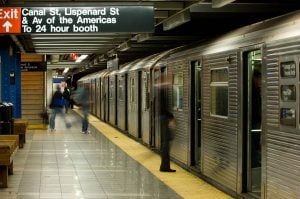Subway Accidents

If you or a loved one has been injured in a subway accident, it is essential that you consult with an experienced New York subway accident attorney at the Law Offices of Kenneth A. Wilhelm. You may be able to receive compensation for the significant injuries, damages and losses that you have sustained and hold the negligent parties accountable.
NYC Subway Accident Statistics
While traveling by New York City’s subways is safe for the most part, we have observed a sharp increase in the number of incidents that resulted in injuries or fatalities. According to MTA’s statistics, there were 58 “collision with individual” deaths on the city’s subway lines last year. There were five non-collision deaths or reports of individuals dying on MTA property due to other causes. Between 2011 and the end of 2014, there were 248 subway deaths in total. According to the National Institutes of Health (NIH), a study that examined subway train fatalities in New York City between Jan. 1, 2003 and May 31, 2007, found that there were 211 subway train-related fatalities.
Common Causes of Subway Accidents
There are different types of accidents and mishaps that may occur on the subway. Here are just a few examples of the types of subway accidents that may result in serious injuries or fatalities.
Slip-and-Fall or Trip-and-Fall Accidents
Uneven or worn surfaces, liquid spills, slick surfaces, broken stairs and poorly maintained escalators pose serious slip-and-fall or trip-and-fall hazards to subway travelers. These types of accidents may result in major injuries or even fatalities. Some of the common types of negligence that led to fall-related injuries and fatalities in subway stations include:
- Broken or defective platforms or stairs
- Missing or inadequate handrails
- Slippery platforms and steps
- Excessive gap between the platform and train
- Inadequate lighting in stations
- Lack of adequate warnings
- Lack of barriers and barricades
Negligent Train Operation
Subway commuters can also be severely injured or killed on the tracks when they are run over by trains that are not operated in a safe manner. Operators who are inexperienced or inadequately trained pose a danger to commuters, as do negligent engineers and conductors. Some of the common examples of negligent operation include:
- Excessive train speed
- Failure to obey traffic control devices
- Failure to properly inspect trains and equipment, which may result in mechanical problems and equipment failure
- Lack of proper communication
- Inadequate equipment
- Lack of proper training for operators, conductors and drivers
- Impaired train operation
- Distracted operation (talking on the cell phone/texting)
- Improperly maintained train doors
Subway Derailments
When derailments occur on the subway, they can be devastating. Derailments may happen due to reckless train operation, a defective rail, debris on the tracks, an impaired or distracted motorman, excessive train speed, etc. The most devastating derailment on New York’s Subway occurred Aug. 28, 1991 when five people were killed and more than 200 were injured when a 4 train came off the tracks at Union Square.
Investigators determined that the motorman was drunk at the time of the crash. He was later convicted of manslaughter. Most recently, a Manhattan-bound F train with 1,000 passengers on board derailed the morning of May 2, 2014 near Broadway and 60th Street in Woodside, Queens, injuring at least 19 people, including four seriously.
Train Collisions
Train collisions on the subway may occur because of a driver’s negligence. Devastating train accidents have occurred nationwide because of a train engineer’s failure to pay attention to the signals. This may occur due to impairment, fatigue, a previously known medical condition, or due to distracted driving.
Train collisions may also happen as the result of mechanical malfunctions caused by brake failure. In such cases, depending on the circumstances of the crash, the city or MTA may be held accountable for the victims’ injuries, damages or losses. Train collisions may cause passengers to get thrown inside the compartment or get ejected from the train, causing catastrophic injuries or even fatalities.
Injuries Suffered in Subway Accidents
Victims who are involved in a subway accident that was caused by either a fall, derailment or collision, or other factors, can suffer a number of serious injuries including, but not limited to, head injuries or traumatic brain injury, spine injuries leading to full or partial paralysis, loss of limbs (amputations) and broken bones or fractures. Also, victims who are flung inside the compartment or ejected can suffer internal injuries and damages to nerves, discs, muscles, joints, tissues, tendons and ligaments.
Recovering from any of these injuries can be a painful, lengthy and costly process. For some of these injuries, victims may have to endure several surgeries, continuing medical treatment and costly rehabilitation. Victims may be temporarily or permanently unable to work or they may work with difficulty and limitations. They may have significantly reduced earnings or be unable to make a livelihood as a result of their injuries.
What to Do if You Have Been Injured
If you have been injured on the subway, it is important to take certain steps to ensure that your legal rights and best interests are preserved. Recently, there have been a number of accidents and injuries because of the large gaps between the train and platform both at New York City and Long Island train stations. If you have been injured as the result of a fall, make a note of whether the gap was clearly marked, and photograph it with your phone if possible.
Check to see if there were any signs posted at the station warning commuters to watch their step. Were the signs clearly visible? Make a note of whether the station was well lit. Make sure you take photographs of where your accident occurred. Take photographs of any defective conditions that may have caused your accident. Get contact information for eyewitnesses who may have seen your injury accident.
File a report with the authorities and get a signed copy of the report for your own records. Get prompt medical attention and treatment for your injuries. Save all receipts that show your medical expenses and any costs you may have incurred as a result of your injuries. Make a note of how many days of work you missed as you recovered from your injuries.
Do not post any information about the accident or your injuries on social media or blogs. Do not post any content including posts or images online. The statements you make, including what you post online, can be used against you during your claims process. Immediately after your accident make sure you or a family member contacts an experienced New York City subway accident attorney who can help ensure that your legal rights are protected every step of the way.
Liability in Subway Accidents
After any subway accident, the facts of the case must be carefully reviewed in order to determine precisely what went wrong. If the accident occurred as a result of poor maintenance of the tracks or the trains, the New York City transit authority can be held liable. Examples of malfunctions include brake failure, defective lighting devices, steering issues and axle malfunctions, etc.
The Metropolitan Transit Authority (MTA) can be held liable if negligent employees caused the accident. For example, the MTA can be held liable for negligent retention of the employee or for negligent hiring of the employee if they employed a driver without a valid Commercial Driver’s License, failed to ensure that the driver did not get sufficient rest before getting on his shift or had a poor driving record. The MTA can also be held responsible if the driver was not properly trained or certified. The New York City Transit Authority also can be held liable for those items mentioned above.
What is Your Claim Worth?
If you have been injured in a New York City subway accident, you may be wondering what your claim is worth. The amount of damages to which you are entitled in a train accident largely depends on the nature and extent of your injuries and the types of losses you have sustained. If you suffered major injuries that left you with permanent disabilities, your claim will be worth a lot more than if you suffered relatively minor injuries.
Injured victims can seek compensation for damages including, but not limited to, medical expenses, lost wages and benefits, lost earning capacity, cost of long-term treatment and care, rehabilitation costs, permanent injury, disability, past and future pain and suffering, etc. An experienced New York personal injury lawyer will be able to factor in damages such as lost future income, loss of livelihood and loss of life’s enjoyment, etc. which are often challenging to calculate.
Damages for Injured Victims
Injured victims of subway accidents can seek compensation for damages such as:
- Medical expenses: These include emergency room costs, hospitalization, surgeries, cost of medication, medical devices, etc.
- Lost wages: This refers to all income that was lost as a result of the injury and the time you had to take off for treatment of the injury.
- Rehabilitation: Any type of therapy that is needed for the victim to regain strength and mobility. Injuries suffered in subway accidents may take weeks or even months or years to heal. This means that a serious injury will put victims out of work for months or even years. Rehabilitation including physical therapy can be extremely costly. Many of these expenses may not even be covered by health insurance and victims may have to pay for them out of pocket.
- Lost future income: If the victim has suffered catastrophic injuries such as a traumatic brain injury or limb amputation, he or she is also entitled to damages for lost future income and loss of his or her livelihood. These are injuries that will have lasting or lifelong impact on the victim and his or her family.
- Past and future pain and suffering: This includes the physical and mental anguish caused to the victim as a result of the injuries.
- Wrongful death: When a subway accident results in a death, the family of the decedent can file what is known as a wrongful death claim seeking compensation for damages such as lost future income, pain and suffering, medical expenses, funeral costs, etc.
Contacting an Experienced Lawyer
If you or a loved one has been injured or if you have lost a loved one in a subway accident, the experienced New York personal injury attorneys at the Law Offices of Kenneth A. Wilhelm can help you better understand your legal rights and options. Our skilled accident attorneys have a proven record of helping injured victims get fair compensation for their losses. In one of our train accident cases, our client was awarded a $3,222,000 verdict.
Please contact us TOLL FREE 24 hours a day, 7 days a week at 1-800-WORK-4-YOU (1-800-967-5496). WE CAN EVEN COME TO YOU. There is no attorneys’ fee unless we recover money for you. We can also help with personal injury cases in New Jersey, Connecticut, Pennsylvania, or Florida. If you have been seriously injured in any of the 50 U.S. states, please call us and we will try to help you with your case.
Other TOLL FREE phone numbers for us are:
1-800-RADIO-LAW, 1-888-WYPADEK, OR 1-800-LAS-LEYES
Please visit us at: www.WORK4YOULAW.com









